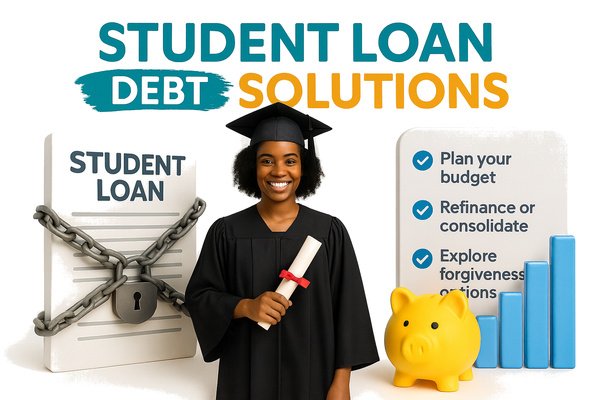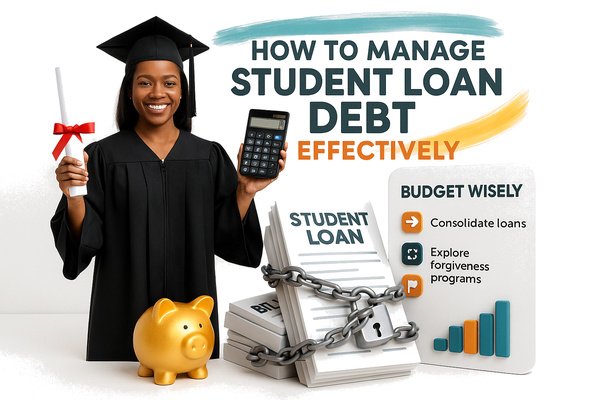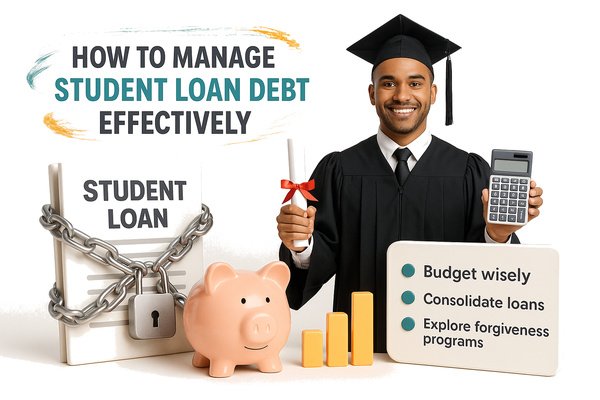Introduction
Student loan debt has become one of the most significant financial burdens for millions of Americans. Whether you’re a recent graduate, a working professional, or returning to school mid-career, learning how to manage student loan debt effectively is essential for maintaining financial stability and peace of mind.
The average borrower in the U.S. carries tens of thousands of dollars in student loan debt. With rising interest rates, complex repayment options, and frequent changes in federal policy, it’s easy to feel overwhelmed. But here’s the good news: managing your student loans doesn’t have to be complicated if you approach it with a clear plan and the right strategies to manage student loan debt effectively from the start.
In this article, we’ll walk you through 7 smart strategies that will help you reduce your student loan burden and gain control of your financial future. Whether your goal is to pay off loans faster, lower your monthly payments, or qualify for forgiveness programs, you’ll find actionable advice tailored to the challenges real borrowers face today.
We’ll cover everything from budgeting and repayment plans to refinancing and staying organized; giving you a roadmap to manage student loan debt effectively with confidence and clarity. Each strategy is built around practical steps you can take, no matter your income or loan balance.
This guide isn’t about quick fixes or unrealistic promises. It’s about helping you build a sustainable plan that fits your life and goals. When you manage student loan debt effectively, you gain more than just financial freedom, you gain peace of mind, the ability to invest in your future, and the confidence to make big life decisions without debt holding you back.
By the end of this guide, you’ll know how to manage student loan debt effectively in 2025 and beyond without sacrificing your long-term financial goals or mental well-being. Let’s dive into the smartest moves you can make to take control of your student loans today.
1. Understand Your Student Loan Types and Terms
The first step in learning how to manage student loan debt effectively is knowing exactly what kind of loans you have and how they work. Many borrowers carry a mix of federal and private student loans, each with different terms, benefits, and repayment options.
Start by gathering details about all your loans:
You can find information about your federal loans by logging into studentaid.gov. For private loans, check your lender’s website or contact customer service directly.
Understanding your loan types is critical because it affects everything from eligibility for income-driven repayment plans to federal forgiveness programs. For example, federal loans often offer more flexibility, including deferment, forbearance, and forgiveness options. Private loans, on the other hand, typically do not.
Here are some terms to familiarize yourself with:
The more you know about the structure of your debt, the more strategic you can be. This knowledge allows you to prioritize loans with higher interest rates, understand how different repayment plans will impact you, and avoid missed payments or penalties.
In short, effective student loan management starts with clarity. When you know what you owe and to whom, you can begin making informed choices to improve your repayment strategy. It’s the foundation for every other step you’ll take to manage student loan debt effectively.
2. Create a Realistic Budget That Prioritizes Loan Payments
Once you understand what you owe, the next step in learning how to manage student loan debt effectively is building a budget that prioritizes repayment without starving the rest of your financial life.
Start by listing all sources of income (salary, freelance work, side hustles, etc.), then subtract your fixed monthly expenses (rent, utilities, groceries, transportation). What’s left is your discretionary income the portion you can use to make extra student loan payments, build savings, or cover personal spending.
Next, assign a specific percentage of your income to student loans. Even if you’re only paying the minimum now, allocating a bit more consistently can significantly reduce your total interest over time. Automating your payments can help you stay on track and avoid missed due dates, which is crucial if you want to manage student loan debt effectively without setbacks.
Prioritize High-Impact Payments
If you’re juggling multiple loans, consider putting any extra funds toward the loan with the highest interest rate even if it’s not your biggest balance. This strategy reduces the total cost of your debt over time and accelerates your path to freedom.
Alternatively, if you’re motivated by quick wins, you might use a debt snowball approach, starting with the smallest balance first to build momentum. Either way, intentional planning helps you manage student loan debt effectively over the long term.
Cut Back with Intention
You don’t need to eliminate all fun to manage your student loans. However, reviewing non-essential spending, subscriptions, dining out, entertainment can free up funds you didn’t realize were available. Even saving $50–$100 a month can lead to meaningful long-term progress and help you manage student loan debt effectively with less stress.
Budgeting apps like YNAB, EveryDollar, or Mint can simplify tracking and help you stay accountable. The clearer your numbers, the more empowered you’ll be to manage student loan debt effectively.
Ultimately, budgeting isn’t about perfection, it’s about consistency. A well-structured budget gives you the visibility to stay in control, reduces financial anxiety, and makes it easier to reach your financial goals.
3. Explore Income-Driven Repayment Plans
If your federal student loan payments feel unmanageable compared to your income, one of the most effective ways to manage student loan debt is by enrolling in an Income-Driven Repayment (IDR) plan. These plans adjust your monthly payment based on your income, family size, and loan balance; providing immediate relief while keeping your loans in good standing.
What Are Income-Driven Repayment Plans?
The four main IDR plans include:
These programs typically cap your payments at 10% to 20% of your discretionary income, and any remaining balance is forgiven after 20 or 25 years of qualifying payments (depending on the plan).
In 2023, the U.S. Department of Education introduced the SAVE Plan, which replaced REPAYE and offers even lower monthly payments and faster forgiveness for smaller loan balances. If you’re not already on an IDR plan, this could be a game-changer for managing student loan debt effectively.
Why IDR Plans Work
Income-driven plans protect you during times of financial hardship or low income. Your payments adjust annually, so if your income drops or you experience a job loss, your payments can decrease significantly or even temporarily become $0.
These plans also help you avoid delinquency and default, which can devastate your credit and financial stability. Staying on an IDR plan keeps your loans in good standing and often opens the door to Public Service Loan Forgiveness (PSLF) eligibility.
How to Apply
You can apply for an IDR plan by visiting studentaid.gov and submitting an online application. Be prepared to provide your most recent tax return or income documentation.
In short, IDR plans are one of the most powerful tools available to federal loan borrowers. If you’re serious about learning how to manage student loan debt effectively, taking advantage of an income-driven repayment plan can create space in your budget while keeping your long-term goals within reach.
4. Consider Federal Loan Forgiveness Programs
If you’re carrying a substantial federal student loan balance, exploring loan forgiveness options could be a smart part of your plan to manage student loan debt effectively. These programs are designed to reward borrowers who work in public service or meet specific criteria over time and in many cases, they can eliminate tens of thousands of dollars in debt.
Public Service Loan Forgiveness (PSLF)
The most well-known option is Public Service Loan Forgiveness (PSLF). This program forgives your remaining loan balance after you make 120 qualifying monthly payments under a qualifying IDR plan while working full-time for a government or eligible nonprofit employer.
To qualify:
Many borrowers miss out on PSLF due to technicalities, so it’s important to read the rules closely and submit documentation consistently. Visit studentaid.gov for the official PSLF Help Tool.
Teacher Loan Forgiveness
If you’re a teacher working in a low-income school or educational service agency, you may qualify for up to $17,500 in loan forgiveness after five consecutive years of service. This program applies to Direct and Stafford Loans but can affect PSLF eligibility, so compare carefully.
Other Options
There are also loan forgiveness programs for:
These options often require service commitments, but they can offer powerful relief, especially when paired with IDR plans or consistent employment in a qualifying field.
Why It Matters
If you qualify, loan forgiveness can drastically reduce or even eliminate your student loan debt. Including forgiveness as part of your broader repayment strategy is a proactive way to manage student loan debt effectively while maximizing long-term financial freedom.
Forgiveness takes planning, paperwork, and patience, but for the right borrower, it’s one of the smartest paths toward debt relief.
5. Make Extra Payments Whenever Possible
One of the most impactful ways to manage student loan debt effectively is to make extra payments whenever you can. Even small additional payments, when applied strategically, can save you thousands of dollars in interest and shave years off your repayment timeline.
The key is to ensure your extra payments go toward the loan principal, not future interest. When making an additional payment, clearly specify that it should be applied to the current loan’s principal balance. Most loan servicers offer this option online or by phone.
Why Extra Payments Work
Student loans accrue interest daily. The longer your balance sits, the more interest piles up. By reducing your principal faster through extra payments, you cut down the amount of interest that can accrue. Over time, this leads to significant savings.
For example, paying just $50 extra per month on a standard 10-year federal loan could shorten your repayment period by more than a year and save you hundreds or even thousands in interest. If you receive a bonus, tax refund, or side income, consider directing some or all of it toward your loans.
How to Do It Consistently
If making large lump-sum payments isn’t feasible, aim for micro-payments. Rounding up your monthly payment or making biweekly payments (half your monthly payment every two weeks) are simple habits that can yield big results. These methods help you stay on track without overwhelming your budget.
You don’t need to sacrifice your entire lifestyle to make progress. Just being intentional with how you use “found money” or discretionary funds can be enough to gain momentum and manage student loan debt effectively over time.
Final Tip
Set a realistic goal, like making one extra payment every quarter and automate it. Even modest consistency will put you ahead. Over time, these small but powerful efforts will improve your payoff plan, reduce stress, and help you manage student loan debt effectively with greater confidence and control.
6. Refinance Your Student Loans Carefully (SEO Optimized)
Refinancing can be a powerful way to lower your interest rate, reduce your monthly payments, or pay off your loans faster, but it’s not the right move for everyone. If you want to manage student loan debt effectively, you must approach refinancing with caution and clarity.
What Is Student Loan Refinancing?
Refinancing involves taking out a new private loan to replace one or more existing loans, federal, private, or both. Your new lender pays off your old balances, and you begin repaying under new terms, ideally with a lower interest rate or better repayment schedule.
When It Makes Sense
Refinancing may help you manage student loan debt effectively if:
Borrowers with excellent credit can often reduce their interest rates by 2% or more, which may result in thousands in interest savings over the life of the loan.
Important Warnings
Refinancing federal loans with a private lender means you will lose access to federal benefits like:
These features offer critical protections during job loss, medical emergencies, or financial hardship. If you’re depending on any of these programs to manage student loan debt effectively, refinancing federal loans could put you at risk.
How to Shop Smart
Compare multiple lenders using tools like Credible or LendKey to check rates without affecting your credit score. Look for:
Refinancing can help you manage student loan debt effectively, but only if it aligns with your financial goals, risk tolerance, and long-term plans. Make sure you’re not giving up valuable protections just to save a little on interest.
7. Stay Organized and Monitor Your Progress (SEO Optimized)
One of the most overlooked, but essential ways to manage student loan debt effectively is by staying organized and consistently tracking your progress. When you know where you stand, you can make smarter decisions, catch mistakes early, and stay motivated throughout your repayment journey.
Track All Your Loans in One Place
If you have multiple student loans with different servicers, it can be difficult to keep everything straight. Use tools like StudentAid.gov, Mint, or Undebt.it to centralize all your balances, due dates, interest rates, and repayment terms. Knowing exactly what you owe allows you to prioritize and strategize more effectively.
Make it a monthly habit to check:
Keeping this information visible helps you stay proactive and manage student loan debt effectively before problems arise.
Use a Debt Payoff Tracker
A visual debt tracker can be surprisingly motivating. Whether you use a spreadsheet, an app, or a printable chart, seeing your balances decrease month by month gives you a tangible sense of achievement. It reminds you that your efforts are paying off, literally.
You can also set micro-goals like:
These goals help you stay focused and prevent burnout.
Set Calendar Reminders and Auto-Pay
Late payments can wreck your credit and make it harder to manage student loan debt effectively. That’s why setting up auto-pay (many lenders even offer interest rate discounts for doing so) or at least calendar alerts can help you stay on track and avoid costly mistakes.
Celebrate Your Progress
Don’t wait until the finish line to celebrate. Acknowledge your wins, like paying off a loan or hitting a savings goal, along the way. Staying positive and engaged is part of long-term success, and that’s what it takes to truly manage student loan debt effectively.
Final Thoughts: Mastering Your Student Loans with Confidence
Student loan debt can feel like a mountain, but with the right tools, mindset, and action plan, you can climb it. Whether you’re a recent graduate or deep into repayment, the strategies outlined in this guide give you the foundation to manage student loan debt effectively and take back control of your financial life.
There’s no one-size-fits-all approach to loan repayment. Some people thrive on the motivation of fast wins; others are laser-focused on saving money over the long term. What matters most is picking the strategy that works best for your goals, lifestyle, and psychology and sticking with it.
Throughout this journey, knowledge is your greatest asset. Understanding your loan terms, interest rates, repayment plans, and forgiveness options puts you ahead of the curve. So does creating a budget that reflects your reality, not just your ideal. When you know exactly where your money is going, it’s easier to direct more of it toward your debt and make measurable progress.
Remember: there are powerful tools available to help you manage student loan debt effectively, from income-driven repayment and refinancing to debt forgiveness and extra payments. Use them wisely, and don’t hesitate to seek help from credit counselors, your loan servicer, or trusted financial advisors. There’s no shame in asking questions or adjusting your plan along the way.
Staying organized, tracking your progress, and celebrating milestones are just as important as making payments. These habits keep your motivation high and your momentum strong, even when the finish line feels far off.
The truth is, paying off student loans isn’t just about numbers, it’s about freedom. The freedom to save, invest, start a family, or take a new job without fear of debt holding you back. That’s why learning how to manage student loan debt effectively is one of the most empowering decisions you can make.
Stay focused, stay informed, and stay consistent. You’ve got this.







